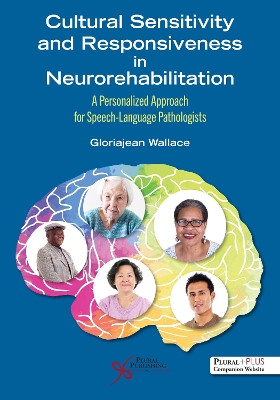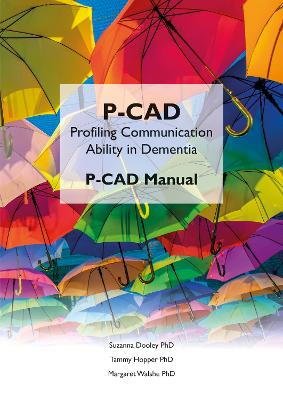Cultural Sensitivity and Responsiveness in Neurorehabilitation
 portes grátis
portes grátis
Cultural Sensitivity and Responsiveness in Neurorehabilitation
A Personalized Approach for Speech-Language Pathologists
Wallace, Gloriajean
Plural Publishing Inc
11/2024
600
Mole
9781635500325
Pré-lançamento - envio 15 a 20 dias após a sua edição
Descrição não disponível.
Acknowledgements
Contributors
Dedication
Part I. Introduction to Personalized Care
Chapter 1. Finding Our North Star: Introduction to Multicultural Neurogenics and Personalized Speech-Language Neurorehabilitation Care for People from Diverse Communities
Gloriajean Wallace
Chapter 2. Implicit Bias
Karen C. Davis and Noma Anderson
Chapter 3. Interprofessional Collaboration and Cultural Competence in Neurorehabilitation
Jeffrey Hecht and Diego Ricardo Baez
Chapter 4. The Multiculturally Competent Clinician's Toolkit to Effective Case Management and Collaborative Practices When Working with Diverse Populations
Maxine B. L. Starr
Chapter 5. Neuro-Rehabilitation Services to Multiethnic Populations with Communication Disorders
Jose Centeno
Chapter 6. Race and Outcomes: Implications for Speech-Language Pathologists Managing Adults with Acquired Aphasia
Charles Ellis, Richard K. Peach, and Patrick M. Briley
Part II. Building a Foundation for Neurorehabilitation in a Multicultural World: Personalization Personified
Chapter 7. Preparing for Case Contact
Carol Westby
Chapter 8. Speech-Language Pathologists (SLPs) Working with Interpreters and Translators in a Medical Setting
Henriette W. Langdon
Chapter 9. Speech, Language, Cognitive, and Swallowing Assessment of Individuals from Culturally and Linguistically Diverse Populations
Gloriajean L. Wallace
Chapter 10. Management of Hearing Loss for Speech-Language Pathologists and Audiologists Who Provide Services to Neurogeriatric Populations from Diverse Communities
Jay Lucker
Chapter 11. Treatment of Individuals from Culturally and Linguistically Diverse Populations: Focus Aphasia
Maria L. Munoz
Chapter 12. A Journey Towards Communication Health and Wellness in Adult Patients and Their Families: Strategies for Communication Sciences and Disorders Practitioners and Students
Carolyn M. Mayo and Robert Mayo
Chapter 13. Complimentary Techniques to Augment Traditional Speech-Language Pathology Services
Rebecca Shisler Marshall, Jacqueline Laures-Gore, and Bijoyaa Mohapatra
Part III: Specialty Neurogenics Chapters
Chapter 14. Aphasia
Samantha Siyambalapitiya, Vishnu KK Nair, Frances Cochrane, and Anne Hyang
Chapter 15. Traumatic Brain Injury in Special Populations
C. Coelho, A.S. Davis. S. Key-DeLyria. A. Lindsey, A.T. Maruca, J. Myers, and N.P. Solomon
Chapter 16. Cultural Considerations in the Assessment of Communication After Right Hemisphere Brain Damage
P. Ferre, R. P. Fonseca, Y. Joanette, M.T. Blake, and J. Minga
Chapter 17. The Dementias
Nidhi Mahendra
Chapter 18. Management of the Dysarthrias: Communication in a Cultural Context
Kathryn Yorkston, Kathryn Lent, Michael I. Burns, and Carolyn Baylor
Chapter 19. Cultural Responsiveness in Dysphagia Practice: Complex Systems
Luis F. Riquelme and Mershen Pillay
Part IV: A Sampling of Information about U.S. Census Bureau Racial/Ethnic Groups
Chapter 20. Blacks and the African Diaspora: Cultural and Communication Factors that Matter Most When Providing Stellar Speech-Language Pathology Care
Gloriajean Wallace
Chapter 21. Hispanics: Richness in Diversity
Silvia Martinez
Chapter 22. Exploring the Diverse Communication and Cultural Landscape of Chinese Americans and Asian Americans: Implications for Healthcare
Anthony Pak-Hin Kong and Lily Li-Rong Cheng
Chapter 23. American Indians and Alaska Natives: Culture, Communication and Clinical Considerations
Ella Inglebret and Rhonda Friedlander
Chapter 24. White Americans: Culture, Communication and Clinical Considerations
Angela Ciccia and Steven J. Cloud
Part V: Intersectionality: Confounding Effect of Factors That Pose Unique Challenges to Care
Chapter 25. Ethical Perspectives for Serving 2SLGBTQIA+ Individuals with Neurogenic Considerations
Ruchi Kapila and Haley Fulk
Chapter 26. Implementing Culturally Responsive and Trauma-Informed Care in Acquired Cognitive Communication Disorders: SLP Considerations for Marginalized and Underserved Populations
Catherine Wiseman-Hakes, Kathryn Y. Hardin, and Maya Albin
Chapter 27. Deaf Community: Culture, Communication and Neurorehabilitation
Kristen K. Maul, Daniel Maier, and Laura Curtin
Part VI: Contributions from Educators and a Look at Neurorehabilitation Care Trends Within the United Stated
Chapter 28. Observations About DEI from an Academician's Perspectives
Diego Ricardo Baez
Chapter 29. Designing Academic and Clinical Courses to Promote DEI Within the Context of Active Learning
Gloriajean Wallace
Chapter 30. SLP Neurorehabilitation Populations Served and Service Trends
Gloriajean Wallace, Rob Mullen, and Karen Beverly-Ducker
Part VII: Interesting Case Scenarios and Practical Clinical Discussions About SLP Neurorehabilitation for People from Diverse Communities
Chapter 31. Collaboration Between a Medical SLP and an Interpreter: A Simulated Case Illustration (with Video)
Henriette W. Langdon and Maxine B. L. Starr (with Hernandez Joel Mancla in role of the Patient)
Chapter 32. Virtual Aphasia Group Treatment in a Life Participation Setting (with Video)
Suzanne Coyle and Brooke Hartfield
Chapter 33. Cultural Adaptation of Cognitive Stimulation Therapy for a Community of Black Older Adults in St. Louis (with Video)
Whitney Anne Postman, Hisako Matsuo, Kailin Leisure, Rebecca Poche, Tayla Slay, Sydney Elizondo, and Elena Everhart
Chapter 34. Co-Creating a Culturally Responsive and Trauma Informed Approach for SLPs Working with Adults with Acquired Neurogenic Cognitive-Communication Disorders: A Case Narrative (with Video)
Catherine Wiseman-Hakes, R. Riess, and Maya Albin
Chapter 35. Case of an African American Nonagenarian with Hearing Loss: Assessing Impact and Designing Treatment (with Video)
Gloriajean Wallace and Gloria Valencia
Chapter 36. Complex Management Considerations for a Multilingual, Multimodal Stroke Survivor with Aphasia from the Deaf Community (with Video)
Kristen Maul, Daniel Maier, and Laura Curtin
Chapter 37. American Samoa and the Military: A Case Demonstrating Where Cultural, Language, Rural Geographic Location, and Military Experience Intersect
Pauline Mashima and Shari Goo-Yoshino
Chapter 38. Impact of Aphasia, Complex Medical Profile, Age, and Work Status in a Post Medical Era: Support Needs and Positive Solutions
Gloriajean Wallace, Sasha Mitkovskiy, and Patrick Carey
Chapter 39. Setting and Achieving Positive Life Participation Outcomes (with Video)
Gloriajean Wallace and Carolina Ulloa
Chapter 40. Reflections on Neurorehabilitation from Speech-Language Pathology Visionaries Across the Globe
Gloriajean Wallace, Isamu Shibamoto, Tamaki Onishi, Pauline Mashima, Gerald C. Imaezue, Jacqueline Stark, Sonia Fredericks, and Amy Wong
Epilogue: Nothing About Us Without Us: People with Neurologically-Based Communication, Cognitive and Swallowing Disorders Share Their Thoughts
Gloriajean L. Wallace, Jenell Gordon, and members of the Louisiana Black Adult Neurogenic Group, the San Francisco State University BIPOC Aphasia Group, the National Aphasia Association's (NAA) Black Aphasia Conversation Group, and Aphasia Vitas (and International Aphasia Group)
Contributors
Dedication
Part I. Introduction to Personalized Care
Chapter 1. Finding Our North Star: Introduction to Multicultural Neurogenics and Personalized Speech-Language Neurorehabilitation Care for People from Diverse Communities
Gloriajean Wallace
Chapter 2. Implicit Bias
Karen C. Davis and Noma Anderson
Chapter 3. Interprofessional Collaboration and Cultural Competence in Neurorehabilitation
Jeffrey Hecht and Diego Ricardo Baez
Chapter 4. The Multiculturally Competent Clinician's Toolkit to Effective Case Management and Collaborative Practices When Working with Diverse Populations
Maxine B. L. Starr
Chapter 5. Neuro-Rehabilitation Services to Multiethnic Populations with Communication Disorders
Jose Centeno
Chapter 6. Race and Outcomes: Implications for Speech-Language Pathologists Managing Adults with Acquired Aphasia
Charles Ellis, Richard K. Peach, and Patrick M. Briley
Part II. Building a Foundation for Neurorehabilitation in a Multicultural World: Personalization Personified
Chapter 7. Preparing for Case Contact
Carol Westby
Chapter 8. Speech-Language Pathologists (SLPs) Working with Interpreters and Translators in a Medical Setting
Henriette W. Langdon
Chapter 9. Speech, Language, Cognitive, and Swallowing Assessment of Individuals from Culturally and Linguistically Diverse Populations
Gloriajean L. Wallace
Chapter 10. Management of Hearing Loss for Speech-Language Pathologists and Audiologists Who Provide Services to Neurogeriatric Populations from Diverse Communities
Jay Lucker
Chapter 11. Treatment of Individuals from Culturally and Linguistically Diverse Populations: Focus Aphasia
Maria L. Munoz
Chapter 12. A Journey Towards Communication Health and Wellness in Adult Patients and Their Families: Strategies for Communication Sciences and Disorders Practitioners and Students
Carolyn M. Mayo and Robert Mayo
Chapter 13. Complimentary Techniques to Augment Traditional Speech-Language Pathology Services
Rebecca Shisler Marshall, Jacqueline Laures-Gore, and Bijoyaa Mohapatra
Part III: Specialty Neurogenics Chapters
Chapter 14. Aphasia
Samantha Siyambalapitiya, Vishnu KK Nair, Frances Cochrane, and Anne Hyang
Chapter 15. Traumatic Brain Injury in Special Populations
C. Coelho, A.S. Davis. S. Key-DeLyria. A. Lindsey, A.T. Maruca, J. Myers, and N.P. Solomon
Chapter 16. Cultural Considerations in the Assessment of Communication After Right Hemisphere Brain Damage
P. Ferre, R. P. Fonseca, Y. Joanette, M.T. Blake, and J. Minga
Chapter 17. The Dementias
Nidhi Mahendra
Chapter 18. Management of the Dysarthrias: Communication in a Cultural Context
Kathryn Yorkston, Kathryn Lent, Michael I. Burns, and Carolyn Baylor
Chapter 19. Cultural Responsiveness in Dysphagia Practice: Complex Systems
Luis F. Riquelme and Mershen Pillay
Part IV: A Sampling of Information about U.S. Census Bureau Racial/Ethnic Groups
Chapter 20. Blacks and the African Diaspora: Cultural and Communication Factors that Matter Most When Providing Stellar Speech-Language Pathology Care
Gloriajean Wallace
Chapter 21. Hispanics: Richness in Diversity
Silvia Martinez
Chapter 22. Exploring the Diverse Communication and Cultural Landscape of Chinese Americans and Asian Americans: Implications for Healthcare
Anthony Pak-Hin Kong and Lily Li-Rong Cheng
Chapter 23. American Indians and Alaska Natives: Culture, Communication and Clinical Considerations
Ella Inglebret and Rhonda Friedlander
Chapter 24. White Americans: Culture, Communication and Clinical Considerations
Angela Ciccia and Steven J. Cloud
Part V: Intersectionality: Confounding Effect of Factors That Pose Unique Challenges to Care
Chapter 25. Ethical Perspectives for Serving 2SLGBTQIA+ Individuals with Neurogenic Considerations
Ruchi Kapila and Haley Fulk
Chapter 26. Implementing Culturally Responsive and Trauma-Informed Care in Acquired Cognitive Communication Disorders: SLP Considerations for Marginalized and Underserved Populations
Catherine Wiseman-Hakes, Kathryn Y. Hardin, and Maya Albin
Chapter 27. Deaf Community: Culture, Communication and Neurorehabilitation
Kristen K. Maul, Daniel Maier, and Laura Curtin
Part VI: Contributions from Educators and a Look at Neurorehabilitation Care Trends Within the United Stated
Chapter 28. Observations About DEI from an Academician's Perspectives
Diego Ricardo Baez
Chapter 29. Designing Academic and Clinical Courses to Promote DEI Within the Context of Active Learning
Gloriajean Wallace
Chapter 30. SLP Neurorehabilitation Populations Served and Service Trends
Gloriajean Wallace, Rob Mullen, and Karen Beverly-Ducker
Part VII: Interesting Case Scenarios and Practical Clinical Discussions About SLP Neurorehabilitation for People from Diverse Communities
Chapter 31. Collaboration Between a Medical SLP and an Interpreter: A Simulated Case Illustration (with Video)
Henriette W. Langdon and Maxine B. L. Starr (with Hernandez Joel Mancla in role of the Patient)
Chapter 32. Virtual Aphasia Group Treatment in a Life Participation Setting (with Video)
Suzanne Coyle and Brooke Hartfield
Chapter 33. Cultural Adaptation of Cognitive Stimulation Therapy for a Community of Black Older Adults in St. Louis (with Video)
Whitney Anne Postman, Hisako Matsuo, Kailin Leisure, Rebecca Poche, Tayla Slay, Sydney Elizondo, and Elena Everhart
Chapter 34. Co-Creating a Culturally Responsive and Trauma Informed Approach for SLPs Working with Adults with Acquired Neurogenic Cognitive-Communication Disorders: A Case Narrative (with Video)
Catherine Wiseman-Hakes, R. Riess, and Maya Albin
Chapter 35. Case of an African American Nonagenarian with Hearing Loss: Assessing Impact and Designing Treatment (with Video)
Gloriajean Wallace and Gloria Valencia
Chapter 36. Complex Management Considerations for a Multilingual, Multimodal Stroke Survivor with Aphasia from the Deaf Community (with Video)
Kristen Maul, Daniel Maier, and Laura Curtin
Chapter 37. American Samoa and the Military: A Case Demonstrating Where Cultural, Language, Rural Geographic Location, and Military Experience Intersect
Pauline Mashima and Shari Goo-Yoshino
Chapter 38. Impact of Aphasia, Complex Medical Profile, Age, and Work Status in a Post Medical Era: Support Needs and Positive Solutions
Gloriajean Wallace, Sasha Mitkovskiy, and Patrick Carey
Chapter 39. Setting and Achieving Positive Life Participation Outcomes (with Video)
Gloriajean Wallace and Carolina Ulloa
Chapter 40. Reflections on Neurorehabilitation from Speech-Language Pathology Visionaries Across the Globe
Gloriajean Wallace, Isamu Shibamoto, Tamaki Onishi, Pauline Mashima, Gerald C. Imaezue, Jacqueline Stark, Sonia Fredericks, and Amy Wong
Epilogue: Nothing About Us Without Us: People with Neurologically-Based Communication, Cognitive and Swallowing Disorders Share Their Thoughts
Gloriajean L. Wallace, Jenell Gordon, and members of the Louisiana Black Adult Neurogenic Group, the San Francisco State University BIPOC Aphasia Group, the National Aphasia Association's (NAA) Black Aphasia Conversation Group, and Aphasia Vitas (and International Aphasia Group)
Este título pertence ao(s) assunto(s) indicados(s). Para ver outros títulos clique no assunto desejado.
Acknowledgements
Contributors
Dedication
Part I. Introduction to Personalized Care
Chapter 1. Finding Our North Star: Introduction to Multicultural Neurogenics and Personalized Speech-Language Neurorehabilitation Care for People from Diverse Communities
Gloriajean Wallace
Chapter 2. Implicit Bias
Karen C. Davis and Noma Anderson
Chapter 3. Interprofessional Collaboration and Cultural Competence in Neurorehabilitation
Jeffrey Hecht and Diego Ricardo Baez
Chapter 4. The Multiculturally Competent Clinician's Toolkit to Effective Case Management and Collaborative Practices When Working with Diverse Populations
Maxine B. L. Starr
Chapter 5. Neuro-Rehabilitation Services to Multiethnic Populations with Communication Disorders
Jose Centeno
Chapter 6. Race and Outcomes: Implications for Speech-Language Pathologists Managing Adults with Acquired Aphasia
Charles Ellis, Richard K. Peach, and Patrick M. Briley
Part II. Building a Foundation for Neurorehabilitation in a Multicultural World: Personalization Personified
Chapter 7. Preparing for Case Contact
Carol Westby
Chapter 8. Speech-Language Pathologists (SLPs) Working with Interpreters and Translators in a Medical Setting
Henriette W. Langdon
Chapter 9. Speech, Language, Cognitive, and Swallowing Assessment of Individuals from Culturally and Linguistically Diverse Populations
Gloriajean L. Wallace
Chapter 10. Management of Hearing Loss for Speech-Language Pathologists and Audiologists Who Provide Services to Neurogeriatric Populations from Diverse Communities
Jay Lucker
Chapter 11. Treatment of Individuals from Culturally and Linguistically Diverse Populations: Focus Aphasia
Maria L. Munoz
Chapter 12. A Journey Towards Communication Health and Wellness in Adult Patients and Their Families: Strategies for Communication Sciences and Disorders Practitioners and Students
Carolyn M. Mayo and Robert Mayo
Chapter 13. Complimentary Techniques to Augment Traditional Speech-Language Pathology Services
Rebecca Shisler Marshall, Jacqueline Laures-Gore, and Bijoyaa Mohapatra
Part III: Specialty Neurogenics Chapters
Chapter 14. Aphasia
Samantha Siyambalapitiya, Vishnu KK Nair, Frances Cochrane, and Anne Hyang
Chapter 15. Traumatic Brain Injury in Special Populations
C. Coelho, A.S. Davis. S. Key-DeLyria. A. Lindsey, A.T. Maruca, J. Myers, and N.P. Solomon
Chapter 16. Cultural Considerations in the Assessment of Communication After Right Hemisphere Brain Damage
P. Ferre, R. P. Fonseca, Y. Joanette, M.T. Blake, and J. Minga
Chapter 17. The Dementias
Nidhi Mahendra
Chapter 18. Management of the Dysarthrias: Communication in a Cultural Context
Kathryn Yorkston, Kathryn Lent, Michael I. Burns, and Carolyn Baylor
Chapter 19. Cultural Responsiveness in Dysphagia Practice: Complex Systems
Luis F. Riquelme and Mershen Pillay
Part IV: A Sampling of Information about U.S. Census Bureau Racial/Ethnic Groups
Chapter 20. Blacks and the African Diaspora: Cultural and Communication Factors that Matter Most When Providing Stellar Speech-Language Pathology Care
Gloriajean Wallace
Chapter 21. Hispanics: Richness in Diversity
Silvia Martinez
Chapter 22. Exploring the Diverse Communication and Cultural Landscape of Chinese Americans and Asian Americans: Implications for Healthcare
Anthony Pak-Hin Kong and Lily Li-Rong Cheng
Chapter 23. American Indians and Alaska Natives: Culture, Communication and Clinical Considerations
Ella Inglebret and Rhonda Friedlander
Chapter 24. White Americans: Culture, Communication and Clinical Considerations
Angela Ciccia and Steven J. Cloud
Part V: Intersectionality: Confounding Effect of Factors That Pose Unique Challenges to Care
Chapter 25. Ethical Perspectives for Serving 2SLGBTQIA+ Individuals with Neurogenic Considerations
Ruchi Kapila and Haley Fulk
Chapter 26. Implementing Culturally Responsive and Trauma-Informed Care in Acquired Cognitive Communication Disorders: SLP Considerations for Marginalized and Underserved Populations
Catherine Wiseman-Hakes, Kathryn Y. Hardin, and Maya Albin
Chapter 27. Deaf Community: Culture, Communication and Neurorehabilitation
Kristen K. Maul, Daniel Maier, and Laura Curtin
Part VI: Contributions from Educators and a Look at Neurorehabilitation Care Trends Within the United Stated
Chapter 28. Observations About DEI from an Academician's Perspectives
Diego Ricardo Baez
Chapter 29. Designing Academic and Clinical Courses to Promote DEI Within the Context of Active Learning
Gloriajean Wallace
Chapter 30. SLP Neurorehabilitation Populations Served and Service Trends
Gloriajean Wallace, Rob Mullen, and Karen Beverly-Ducker
Part VII: Interesting Case Scenarios and Practical Clinical Discussions About SLP Neurorehabilitation for People from Diverse Communities
Chapter 31. Collaboration Between a Medical SLP and an Interpreter: A Simulated Case Illustration (with Video)
Henriette W. Langdon and Maxine B. L. Starr (with Hernandez Joel Mancla in role of the Patient)
Chapter 32. Virtual Aphasia Group Treatment in a Life Participation Setting (with Video)
Suzanne Coyle and Brooke Hartfield
Chapter 33. Cultural Adaptation of Cognitive Stimulation Therapy for a Community of Black Older Adults in St. Louis (with Video)
Whitney Anne Postman, Hisako Matsuo, Kailin Leisure, Rebecca Poche, Tayla Slay, Sydney Elizondo, and Elena Everhart
Chapter 34. Co-Creating a Culturally Responsive and Trauma Informed Approach for SLPs Working with Adults with Acquired Neurogenic Cognitive-Communication Disorders: A Case Narrative (with Video)
Catherine Wiseman-Hakes, R. Riess, and Maya Albin
Chapter 35. Case of an African American Nonagenarian with Hearing Loss: Assessing Impact and Designing Treatment (with Video)
Gloriajean Wallace and Gloria Valencia
Chapter 36. Complex Management Considerations for a Multilingual, Multimodal Stroke Survivor with Aphasia from the Deaf Community (with Video)
Kristen Maul, Daniel Maier, and Laura Curtin
Chapter 37. American Samoa and the Military: A Case Demonstrating Where Cultural, Language, Rural Geographic Location, and Military Experience Intersect
Pauline Mashima and Shari Goo-Yoshino
Chapter 38. Impact of Aphasia, Complex Medical Profile, Age, and Work Status in a Post Medical Era: Support Needs and Positive Solutions
Gloriajean Wallace, Sasha Mitkovskiy, and Patrick Carey
Chapter 39. Setting and Achieving Positive Life Participation Outcomes (with Video)
Gloriajean Wallace and Carolina Ulloa
Chapter 40. Reflections on Neurorehabilitation from Speech-Language Pathology Visionaries Across the Globe
Gloriajean Wallace, Isamu Shibamoto, Tamaki Onishi, Pauline Mashima, Gerald C. Imaezue, Jacqueline Stark, Sonia Fredericks, and Amy Wong
Epilogue: Nothing About Us Without Us: People with Neurologically-Based Communication, Cognitive and Swallowing Disorders Share Their Thoughts
Gloriajean L. Wallace, Jenell Gordon, and members of the Louisiana Black Adult Neurogenic Group, the San Francisco State University BIPOC Aphasia Group, the National Aphasia Association's (NAA) Black Aphasia Conversation Group, and Aphasia Vitas (and International Aphasia Group)
Contributors
Dedication
Part I. Introduction to Personalized Care
Chapter 1. Finding Our North Star: Introduction to Multicultural Neurogenics and Personalized Speech-Language Neurorehabilitation Care for People from Diverse Communities
Gloriajean Wallace
Chapter 2. Implicit Bias
Karen C. Davis and Noma Anderson
Chapter 3. Interprofessional Collaboration and Cultural Competence in Neurorehabilitation
Jeffrey Hecht and Diego Ricardo Baez
Chapter 4. The Multiculturally Competent Clinician's Toolkit to Effective Case Management and Collaborative Practices When Working with Diverse Populations
Maxine B. L. Starr
Chapter 5. Neuro-Rehabilitation Services to Multiethnic Populations with Communication Disorders
Jose Centeno
Chapter 6. Race and Outcomes: Implications for Speech-Language Pathologists Managing Adults with Acquired Aphasia
Charles Ellis, Richard K. Peach, and Patrick M. Briley
Part II. Building a Foundation for Neurorehabilitation in a Multicultural World: Personalization Personified
Chapter 7. Preparing for Case Contact
Carol Westby
Chapter 8. Speech-Language Pathologists (SLPs) Working with Interpreters and Translators in a Medical Setting
Henriette W. Langdon
Chapter 9. Speech, Language, Cognitive, and Swallowing Assessment of Individuals from Culturally and Linguistically Diverse Populations
Gloriajean L. Wallace
Chapter 10. Management of Hearing Loss for Speech-Language Pathologists and Audiologists Who Provide Services to Neurogeriatric Populations from Diverse Communities
Jay Lucker
Chapter 11. Treatment of Individuals from Culturally and Linguistically Diverse Populations: Focus Aphasia
Maria L. Munoz
Chapter 12. A Journey Towards Communication Health and Wellness in Adult Patients and Their Families: Strategies for Communication Sciences and Disorders Practitioners and Students
Carolyn M. Mayo and Robert Mayo
Chapter 13. Complimentary Techniques to Augment Traditional Speech-Language Pathology Services
Rebecca Shisler Marshall, Jacqueline Laures-Gore, and Bijoyaa Mohapatra
Part III: Specialty Neurogenics Chapters
Chapter 14. Aphasia
Samantha Siyambalapitiya, Vishnu KK Nair, Frances Cochrane, and Anne Hyang
Chapter 15. Traumatic Brain Injury in Special Populations
C. Coelho, A.S. Davis. S. Key-DeLyria. A. Lindsey, A.T. Maruca, J. Myers, and N.P. Solomon
Chapter 16. Cultural Considerations in the Assessment of Communication After Right Hemisphere Brain Damage
P. Ferre, R. P. Fonseca, Y. Joanette, M.T. Blake, and J. Minga
Chapter 17. The Dementias
Nidhi Mahendra
Chapter 18. Management of the Dysarthrias: Communication in a Cultural Context
Kathryn Yorkston, Kathryn Lent, Michael I. Burns, and Carolyn Baylor
Chapter 19. Cultural Responsiveness in Dysphagia Practice: Complex Systems
Luis F. Riquelme and Mershen Pillay
Part IV: A Sampling of Information about U.S. Census Bureau Racial/Ethnic Groups
Chapter 20. Blacks and the African Diaspora: Cultural and Communication Factors that Matter Most When Providing Stellar Speech-Language Pathology Care
Gloriajean Wallace
Chapter 21. Hispanics: Richness in Diversity
Silvia Martinez
Chapter 22. Exploring the Diverse Communication and Cultural Landscape of Chinese Americans and Asian Americans: Implications for Healthcare
Anthony Pak-Hin Kong and Lily Li-Rong Cheng
Chapter 23. American Indians and Alaska Natives: Culture, Communication and Clinical Considerations
Ella Inglebret and Rhonda Friedlander
Chapter 24. White Americans: Culture, Communication and Clinical Considerations
Angela Ciccia and Steven J. Cloud
Part V: Intersectionality: Confounding Effect of Factors That Pose Unique Challenges to Care
Chapter 25. Ethical Perspectives for Serving 2SLGBTQIA+ Individuals with Neurogenic Considerations
Ruchi Kapila and Haley Fulk
Chapter 26. Implementing Culturally Responsive and Trauma-Informed Care in Acquired Cognitive Communication Disorders: SLP Considerations for Marginalized and Underserved Populations
Catherine Wiseman-Hakes, Kathryn Y. Hardin, and Maya Albin
Chapter 27. Deaf Community: Culture, Communication and Neurorehabilitation
Kristen K. Maul, Daniel Maier, and Laura Curtin
Part VI: Contributions from Educators and a Look at Neurorehabilitation Care Trends Within the United Stated
Chapter 28. Observations About DEI from an Academician's Perspectives
Diego Ricardo Baez
Chapter 29. Designing Academic and Clinical Courses to Promote DEI Within the Context of Active Learning
Gloriajean Wallace
Chapter 30. SLP Neurorehabilitation Populations Served and Service Trends
Gloriajean Wallace, Rob Mullen, and Karen Beverly-Ducker
Part VII: Interesting Case Scenarios and Practical Clinical Discussions About SLP Neurorehabilitation for People from Diverse Communities
Chapter 31. Collaboration Between a Medical SLP and an Interpreter: A Simulated Case Illustration (with Video)
Henriette W. Langdon and Maxine B. L. Starr (with Hernandez Joel Mancla in role of the Patient)
Chapter 32. Virtual Aphasia Group Treatment in a Life Participation Setting (with Video)
Suzanne Coyle and Brooke Hartfield
Chapter 33. Cultural Adaptation of Cognitive Stimulation Therapy for a Community of Black Older Adults in St. Louis (with Video)
Whitney Anne Postman, Hisako Matsuo, Kailin Leisure, Rebecca Poche, Tayla Slay, Sydney Elizondo, and Elena Everhart
Chapter 34. Co-Creating a Culturally Responsive and Trauma Informed Approach for SLPs Working with Adults with Acquired Neurogenic Cognitive-Communication Disorders: A Case Narrative (with Video)
Catherine Wiseman-Hakes, R. Riess, and Maya Albin
Chapter 35. Case of an African American Nonagenarian with Hearing Loss: Assessing Impact and Designing Treatment (with Video)
Gloriajean Wallace and Gloria Valencia
Chapter 36. Complex Management Considerations for a Multilingual, Multimodal Stroke Survivor with Aphasia from the Deaf Community (with Video)
Kristen Maul, Daniel Maier, and Laura Curtin
Chapter 37. American Samoa and the Military: A Case Demonstrating Where Cultural, Language, Rural Geographic Location, and Military Experience Intersect
Pauline Mashima and Shari Goo-Yoshino
Chapter 38. Impact of Aphasia, Complex Medical Profile, Age, and Work Status in a Post Medical Era: Support Needs and Positive Solutions
Gloriajean Wallace, Sasha Mitkovskiy, and Patrick Carey
Chapter 39. Setting and Achieving Positive Life Participation Outcomes (with Video)
Gloriajean Wallace and Carolina Ulloa
Chapter 40. Reflections on Neurorehabilitation from Speech-Language Pathology Visionaries Across the Globe
Gloriajean Wallace, Isamu Shibamoto, Tamaki Onishi, Pauline Mashima, Gerald C. Imaezue, Jacqueline Stark, Sonia Fredericks, and Amy Wong
Epilogue: Nothing About Us Without Us: People with Neurologically-Based Communication, Cognitive and Swallowing Disorders Share Their Thoughts
Gloriajean L. Wallace, Jenell Gordon, and members of the Louisiana Black Adult Neurogenic Group, the San Francisco State University BIPOC Aphasia Group, the National Aphasia Association's (NAA) Black Aphasia Conversation Group, and Aphasia Vitas (and International Aphasia Group)
Este título pertence ao(s) assunto(s) indicados(s). Para ver outros títulos clique no assunto desejado.







